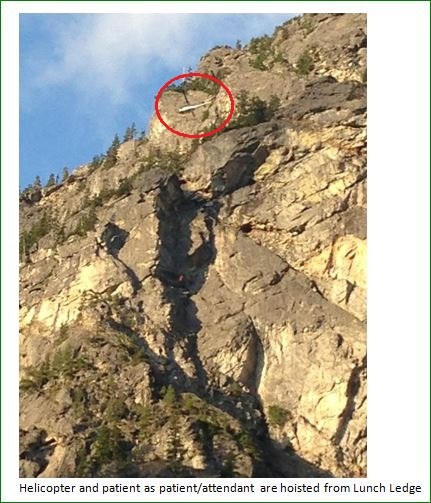
An Intermediate Rock Climb of Guye Peak could have become problematic were it not for planning, open communication, and skill of the climbers and rescuers. Here's our safety report from a trip up Guye Peak:
[Climb Leader]
After ascending the talus field below the west face of Guye Peak, we scrambled the lower sections and belayed a portion of a ramp angling to the left, bypassing the first pitch, which goes directly up to Lunch Ledge. From the top of the ramp (tree belay) we scrambled up a short section to a ledge to set up belay anchors and begin the roped climbing.
The climber began his lead on the Improbable Traverse, setting 3 pieces of protection as he moved to the right and up to ledges to begin the traverse of the face. At this point, he fell 20-30 feet.
He landed feet first on a small ledge, tumbling to his back and somersaulting over. The climber ended up hanging from his protection 30 – 40 feet to the right and slightly below the belay ledge.
The party helped him climb back to Lunch Ledge using a fixed line. It was determined that his injuries (ankles and lower back) were too severe to continue the climb or to descend.
911 was called at 11:50AM. The first Search and Rescue (SAR) teams started climbing at 2:02pm. Regular communication was soon established with the SAR personnel via Family Radio Service (FRS) radios.
We were directed to leave an attendant with the injured climber, and to begin our descent down the mountain. Our First Aid leader stayed behind and continued to care for the injured climber, communicating the climber’s condition to SAR on a regular basis.
[SAR]
After discussing tactics, 3 SAR teams headed up the Guye Peak trail with liter and climbing gear in order to approach the fallen climber from above, with a plan to descend to the injured climber, then lower him down. A helicopter rescue was not thought possible. Our remaining teams were sent up the scree field from below to place hand lines and assist with the litter.
Meanwhile, at 6:35pm, a King County Sheriff's helicopter, Guardian 2, made one attempt to retrieve the subject, lowering a deputy down 241 feet of a 250’ line. The deputy was somehow able to pendulum across to the ledge and hook on to the subject’s harness. It was an amazing rescue, enabling the injured climber to reach medical care at least 12 hours sooner and greatly reducing the risk to our SAR field teams.
At this stage the stranded first aid leader, left behind after the helicopter extraction, became our subject. He was an experienced climber and uninjured but unable to descend due to lack of ropes.
5 SAR personnel rappelled over 1000 feet, down the cliff face to stranded climber. Other rescuers remained in the scree field below to provide to provide support. By 02:30am the next morning, the stranded climber and rappel team were back at SAR base.
King County Sheriff's Office posted the helicopter hoist operation to YouTube. Note how close the rotors came to the rock.
There was a lot of climbing equipment left on the mountain, including ropes: an easy trade in order to keep the mission as safe as possible. The equipment was retrieved over the following 2 weeks. In total, 54 rescuers took part, including 11 from Seattle Mountain Rescue and 12 from Everett Mountain Rescue.
[Climb Leader]
The response by the climbing team after the incident was handled extremely well. Everyone did their part and remained calm. Communication by team members with emergency response providers was handled in a calm and measured manner.
Excellent care was provided to the patient over a 7 hour period from when the fall occurred until he was removed by helicopter from the ledge. The idea to rig a fixed line to help the climber return to the ledge was an appropriate solution and demonstrated excellent problem solving.
Of special note, the injured climber’s ability to climb back to the ledge after suffering painful and debilitating injuries demonstrated a massive amount of will, toughness, and determination. It was not easy to do but greatly simplified the rescue. Had the injured climber not been able to climb back to the ledge, it would have been critical for the team to build and execute a raise system.
Everyone executed their assignments with minimal direction, working together as a team to initiate the rescue, care for the patient, and descend the mountain safely. There were two experienced leaders on the climb, and it was noted by participants that both leaders continued to lead the team, while permitting the discussion of key issues, so the team felt a sense of participation and direction.
[Climb Leader]
KCSAR (King County Search And Rescue) did an incredible job of organizing and executing a complex rescue, mounting a massive response and rescue operation involving both a very difficult helicopter evacuation and rappelling down 1000' of complex technical terrain in the dark to safely extract our first aid leader from the belay ledge. The professionalism and enthusiasm demonstrated was outstanding.
Feedback from SAR and King County Sheriff Deputies was that our team handled the situation appropriately. They particularly noted that the team remained calm in their communications, provided good information, which allowed KCSAR to focus on the task at hand rather than having to manage the emotions of a panic stricken party.
I am proud of our climbing team for how they handled this challenging situation, and extremely grateful to Search and Rescue for executing this complex rescue.
 David Shema
David Shema